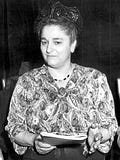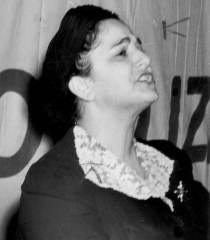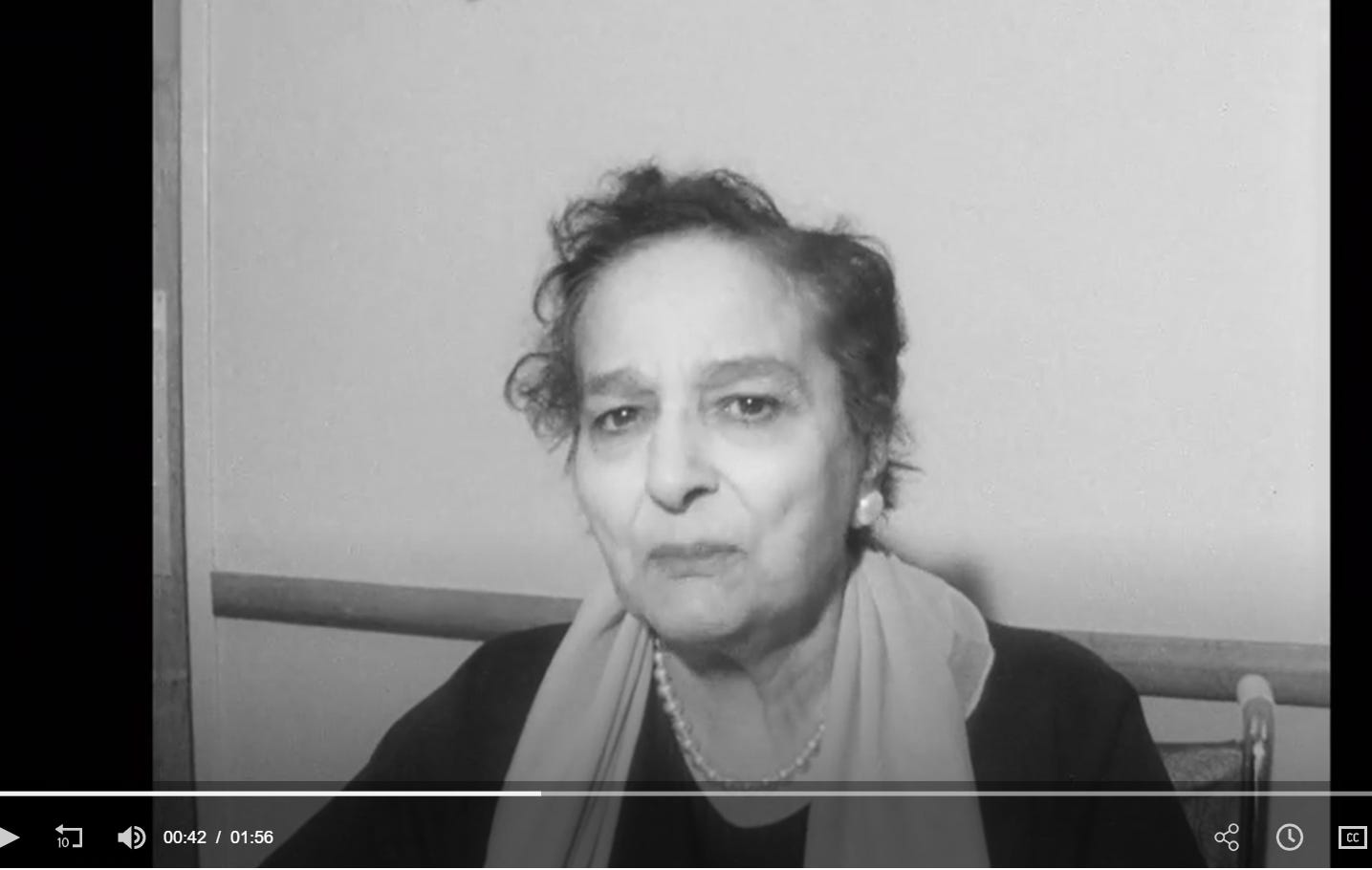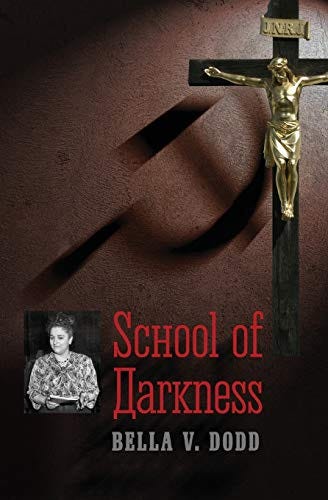School of Darkness & Salvation
Bella V. Dodd, School of Darkness author, was a 20th-century American Communist Party activist and, later, a prominent anti-Communist.
I did not become a Communist overnight. It came a little at a time. I had been conditioned by my education and association to accept this materialistic philosophy. Now came new reasons for acceptance. I was grateful for communist support in the struggles of the Instructors Association. I admired the selfless dedication of many who belonged to the Party. They took me into their fraternal circle and made me feel at home. I was not interested in any long-range Party objectives but I did welcome their assistance on immediate issues, and I admired them for their courage. Most of all I respected the way they fought for the forgotten man of the city. So I did not argue with them about the “dictatorship of the proletariat” which they talked about, or about its implications.
Bella Dodd, School of Darkness
Introduction
Bella Dodd (1904-1969), the youngest of ten children, was born Maria Assunta Isabella Visono in Picerno, Italy. Her Catholic family immigrated to the United States in 1909. They were destitute and stopped going to Church. They settled in the Hell’s Kitchen neighborhood of Manhattan, New York City. The Visonos faced discrimination and struggled to make ends meet, which made for a challenging childhood for Bella.
In 1916, Bella suffered a horrific trolley car accident that permanently scarred her and delayed her much-anticipated entry into high school. While returning home on the trolley, she signaled the operator to stop. She was thrown into the street upon stepping off the vehicle, catching her left foot under the trolley car wheels. Her father arrived and carried Bella to the doctor’s office. The doctor had her transported to the local hospital. There, surgeons removed Bella’s foot. She spent an agonizing year in the hospital undergoing five surgeries, all botched. In the end, Bella’s mother brought her home to recuperate. As her wounds healed, she read everything her mother had got her from the local library. That year, Bella lost her beloved sister, Katie, to the worldwide influenza epidemic. It was indeed a sad time for the Visono family.
The following year, Bella was well enough to enroll in the local public high school. Although her body was handicapped, her will was undaunted. Bella walked ten blocks to her school on crutches and forced herself to participate in school activities. The addition of an appliance, though awkward, allowed her to discard the crutches and even join in hikes as a member of the Naturalists’ Club.
Despite the difficulties, Bella was an exceptional student and received a scholarship to Hunter College, where she earned a bachelor’s degree in philosophy in 1924. She continued her studies at Columbia University, earning a master’s degree in political science in 1928. In the fall of 1925, Bella got her first job as a substitute history teacher at Seward Park High School. In February 1926, she began teaching at Hunter College. After completing her undergraduate degree, Bella earned a law degree from New York University while teaching at Seward Park High School. She passed the New York bar in 1931 and that same year, in a civil ceremony, married the “freethinker” John Dodd. Because of Bella’s increasing activities in the CPUSA, the couple divorced in 1940. They had no children.
Bella’s experiences growing up in poverty and witnessing the struggles of the working class inspired her to become involved in socialist and communist activism. Her involvement with Communism began in the 1930s. Bella joined the John Reed Club, which sought to spread Marxist-Leninist beliefs throughout America. She was a member of the Communist Party’s National Committee and served as the head of the New York City Teachers Union.
As a communist, Bella played a significant role in the labor movement and was crucial in the Party’s efforts to influence labor unions. Her autobiography, School of Darkness, provides a detailed account of the communist influence. In particular, the labor unions and how communists affected the labor movement in the United States.
Bella was a leader of the Communist Party of America (CPUSA) in the 1930s and 1940s. She also served as legal counsel (attorney) for the Communists. Bella served as its National Chairwoman from 1945 to 1948. However, she became disillusioned with the Communist Party and left the organization. Bella later became an outspoken critic of Communism.
In her testimony and writings, Bella described the Communist Party’s tactics of infiltration and deception. She warned of the dangers of the Communist movement. Bella’s insights exposed the tactics and strategies of the Communist Party.
Labor Unions
Bella shows us that the CPUSA had a deliberate and systematic plan. Its main goal was to infiltrate labor unions and control them from within. This plan involved placing communist activists and sympathizers in leadership positions. There, they could steer union policy and activities to support communist aims.
According to Bella, the CPUSA saw labor unions as a critical avenue for advancing their goals of socialism and Communism in the United States. They believed the working class was a natural ally in the fight against capitalism. The labor movement could be a powerful social and political change force.
Bella describes how the CPUSA used various tactics to infiltrate and control labor unions. One such tactic was the creation of “red locals,” which were communist-controlled. They worked to gain control of larger unions. The CPUSA also created front organizations that appeared to be legitimate labor groups.
Once inside the labor unions, the communists worked to promote their agenda and subvert the union’s goals. That often involved supporting strikes and other disruptive actions. Those actions served communist aims but were detrimental to the union and its members. The communists also sought to undermine the authority of union leadership. They replaced leadership with communist-controlled people.
Bella’s account of the communist influence in labor unions warns about the dangers of ideological extremism. She shows us the need for vigilance in protecting institutions. Bella detailed how the CPUSA used deceit and manipulation. They infiltrated and controlled labor unions, which had severe consequences.
Rejection
In the early 1940s, as the Cold War began, Bella began to rethink her commitment to Communism. The death of Lenin, the show trials of the 1930s, and the purges of Stalin’s regime made her question the ideals she had embraced. In particular, Bella felt betrayed by the Soviet Union’s harsh treatment of its former ally, Yugoslavia.
In 1949, Bella resigned from the CPUSA and began cooperating with the FBI and the U.S. House of Representatives Committee on Un-American Activities. In April 1952, she appeared before the Committee. Bella gave testimony that provided insight into the inner workings of the CPUSA and the Communist movement. Bella’s testimony was notable for several reasons. She spoke about the CPUSA’s efforts to infiltrate and influence American institutions. Bella noted the influence of trade unions, educational institutions, and the media. She also revealed the extent to which the Soviet Union controlled and funded the CPUSA and the Communist parties in other countries.
Communist Infiltration of the Catholic Church
Speaking as a former high-ranking official of the American Communist Party, Bella said: “In the 1930s, we put eleven hundred men into the priesthood to destroy the Church from within.”1 The idea was for these men to advance through ordination and later achieve influence and authority as Monsignors and Bishops. A dozen years before Vatican II, she stated, “Right now they are in the highest places in the Church.”2 That’s where they worked to bring change to weaken the Church’s effectiveness against Communism. She also said these changes would be so drastic that “you will not recognize the Catholic Church.” These words would prove true after the Second Vatican Council (1962-1965). We have seen the absolute destruction of faith, morals, doctrine, and Tradition. The Second Vatican Council’s abuses include the Church’s modernization through the ‘New’ Mass and sacraments. Also, see Frederick R. Smith Speakes, The Keys of This Blood and Control of the New World Order.
There is also the corroborating incident from the 1960s. A French nurse, Marie Carre, attended an auto-crash victim at her unnamed hospital. The man lingered near death for a few hours and then died. He had no identification, but he had a briefcase with brief autobiographies. She kept these notes and read them. Because of the extraordinary content, Carre decided to publish them. The result is the AA-1025 Memoirs of the Communist Infiltration Into the Church. It is a strange and fascinating account of a Communist who entered the Catholic priesthood. That spy and many others intended to infiltrate and, from within, destroy the Church. The strange yet fascinating and illuminating set of biographical notes details the crash victim’s mission. It describes the priesthood and his experiences in the seminary. The book shows the means and methods he used and promoted to help effect the auto-dissolution of the Catholic Church.
In 2000, Herbert Romerstein and Eric Breindel authored the book entitled The Venona Secrets — Exposing Soviet Espionage and America’s Traitors, published by Regnery Publishing, Inc. Their research turned up archival material that confirmed the existence of an operation called “Outstretched Hand,” to infiltrate Communists into the Roman Catholic church.3
Salvation
Bella’s Congressional testimony received both support and criticism in the media. Some praised her bravery in speaking out against Communism, while others (the leftists) accused her of being a liar and a traitor. Her testimony was a significant event in the Cold War’s early stages and helped shape public opinion about Communism in the United States.
Bella’s congressional testimony was essential in the early stages of the Cold War and the Red Scare. Her testimony provided valuable insight into the inner workings of the CPUSA. Bella’s experience helped to shape public opinion about Communism in the United States. Despite the criticism, her testimony remains an integral part of American history.
Thanks to the great Archbishop Fulton Sheen (1895–1979), Bella reentered the Catholic Faith in 1952. Here is the great Archbishop teaching us about the evils of Communism.
In the following years, Bella devoted her life to making amends for her past affiliations. She toured college campuses, churches, and community centers, exposing the dangers of Communism and the power of faith.
Below is a 1966 video clip of Bella recorded by WBAP-TV station in Fort Worth, Texas, at Texas Christian University. Note how she discusses Marxist professors infesting academia. The audio begins at 1:56.
In 1968, Bella ran on the New York Conservative Party ticket to become a member of the U.S. Congress. She came in last place with 3% of the vote against Democratic incumbent Leonard Farbstein (easily reelected with 53%). The other candidates included Donald Weeden (Republican), Ralph Denat (Liberal), and David McReynolds (Peace and Freedom).
On April 29, 1969, at age 64, Bella died in Manhattan, New York, after undergoing gall bladder surgery. She was buried at Gate of Heaven Cemetery in Pleasantville, New York.
School of Darkness
Bella Dodd’s book School of Darkness (1954) is the primary source for this essay. It provides an in-depth account of her experiences as a member of the Communist Party and her later opposition to the Communist movement. Bella offers a unique perspective on the Communist Party’s methods of infiltration and control. She describes the tactics used to gain influence in various organizations. Bella detailed the strategies used to promote Communist ideology. The book is a powerful testimony to the dangers of Communism and serves as a warning to those who might support this collectivist movement. Bella reveals that financiers worked “to control the common man” and advance world tyranny through Communism.
The below quote from the book on pages 52-54 foretold the world today as we see with the woke secular worldview. That collectivist religion fulfills many tenants of the communist ecosystem (emphasis added):
During the spring of 1930 I took the Medina cram courses and prepared for the examination for admission to the New York Bar. The examination over, I requested a leave of absence from the college and with my friend Beatrice left for Europe. In a foolish kind of way I hoped to find there answers which were not forthcoming at home. I was tired and restless. I wanted to escape from all sense of responsibility. I was young and I wanted to enjoy life.
It was a trip rich in new contacts. With a capacity to make friends, I found people of interest in every walk of life in the different countries we visited. It was on this trip that I was to meet my future husband, John Dodd.
We landed in Hamburg and I found it an exciting city, filled with merchant seamen, longshoremen, soldiers. There were the nouveau riche with pockets bulging with the country’s wealth. There were Communists everywhere, marching, singing, meeting. There were the decadent risqué night spots. There were also fine old restaurants, old homes and churches, and other evidences of an earlier day. It was a city of contrasts.
Too frequently, we came face to face with middle-class Germans with pinched, strained faces, ready, when they noted sympathy, to tell you their troubles. The thing that struck me was their bewilderment. They neither understood the cause of their predicament nor where they were going. We looked at them and listened. But we were Americans with dollars in our purses, bent on having a good time.
In Berlin, we saw more pinched faces and more blatant lavishness. We were alarmed at the frank and open evidences of sexual and moral degradation flaunted in the night spots and exhibited to the tourists everywhere. The atmosphere of the city seemed charged as the air is before an electric storm. I found some of my friends from Hunter College at the University of Berlin and we had the opportunity to see what was happening at the seats of learning. We talked with university students and professors. The university was torn with strife. Socialists, Communists, National Socialists were battling each other and jointly undermining those who regarded themselves as conservatives attached to their own country by the natural love of one’s homeland. Acts of violence were common in the city and around the university.
I was conscious of the fact that here politics had become a matter of life and death. I was conscious also that the intellectuals, the teachers, professors, and scientists were arrogant in their pride but lacked the inner strength to play a salutary role in that country’s hour of need. Here were men of the highest intellectual achievements who were ready to attach themselves to the forces of violence. I did not then realize, as I now do, that for close to a century the educational world of Germany had been subjected to systematic despiritualization which could result only in the dehumanization now apparent. This made it possible for such despiritualized men to serve both the Nazi and later the communist power [Partys] with a terrifying loyalty and efficiency.
Moreover, on page 158, Bella succinctly describes the brutal reality of totalitarianism (of any type):
This is the peculiar paradox of modern totalitarianism. This is the key to the mental enslavement of mankind: that the individual is made into nothing, that he operates as the physical part of what is considered a higher group intelligence and acts at the will of that higher intelligence, that he has no awareness of the plans the higher intelligence has for utilizing him. When a person conditioned by a totalitarian group talks about the right not to incriminate himself, he really means the right not to incriminate the communist group of which he is only a nerve end. When he talks of freedom of speech, he means freedom for the communist group to speak as a group through the mouth of the individual who has been selected by the higher intelligence.
The Bill of Rights of the American Constitution was written to protect individuals against centralized power. The Communists pervert this safeguard by first enslaving the individual so that he becomes the marionette of the centralized power.
As shown above, Bella’s straightforward and engaging writing style makes School of Darkness informative. The book is well-researched and provides a wealth of information about the Communist Party. It details the Communist Party’s activities during the 20th century.
Reflection
As described by Bella in her book, the collectivist leaders of today and yesteryear, by and large, are wealthy demagogues. The icons of Marx, Engels, Stalin, and Mao were children of the wealthy elitist class. Castro and his brothers had it all from his father’s sugar business. By taking over Cuba, Fidel, the “humble worker,” ended up with over 900 million at his death in 2016.4
Bill Ayers is an admitted Marxist terrorist and friend of Barack Obama, the spoiled son of Thomas Ayers, CEO of Consolidated Edison. Obama is now enjoying retirement in his D.C. mansion and 11.5 million dollars in humble abodes at Martha’s Vineyard and Hawaii. BLM co-founder Patrisse Cullors is the poster child of this fake icon collection. Proud as a peacock, she touts her claim to be “a trained Marxist.” Indeed, like all the other collectivist “leaders,” she accumulated a lot of money and power. Like the book Animal Farm, all animals are equal, but some are more equal than others.5
Conclusion
School of Darkness is a recommended book for anyone interested in the history of Communism. It details the collectivist worldview and its continued impact on American society. Whether you are a student of history, a political activist, or someone interested in the topic, this book is a must-read. It provides a valuable perspective on one of the most significant movements of the 20th century. We face many communist tenants in new forms of repression, such as the post-modern “corporatocracy.”6
Thank you, Bella, and RIP.📕
Additional Resources
Rethinking Bella Dodd and Infiltration of the Catholic Priesthood ~ by Keven Symons, Homiletic & Pastoral Review, December 24, 2021
Letter #48, 2018: “Some enemy has done this” ~ Inside the Vatican, September 1, 2018
The Venona Secrets — Exposing Soviet Espionage and America’s Traitors ~ by Herbert Romerstein and Eric Breindel, 608 pages, Regnery History, October 2000
The Devil and Bella Dodd: One Woman’s Struggle Against Communism and Her Redemption ~ by Nicholas Mary & Kengor Paul, 422 pages, TAN Books, November 2017
Paul Kengor: Co-Author of The Devil and Bella Dodd ~ YouTube video
For an exhausting analysis of Bella’s quote about the priesthood infiltration, please see Rethinking Bella Dodd and Infiltration of the Catholic Priesthood
Ibid
Frederick R. Smith Speakes, Madness Made to Order - Part Four ~ by Frederick R. Smith, R. Smith ~ July 22, 2022
Corporatocracy is the modern fusion of government, legacy media, woke big business, the medical industry, and academia. This unholy alliance cancels cogent thinking, the natural family, medical freedom, national sovereignty, sound money, and the incentive to work.










https://unconstrainedanalytics.org/wp-content/uploads/2019/07/Bella-Dodd-June-July-1953-HUAC-Testimony-1.pdf